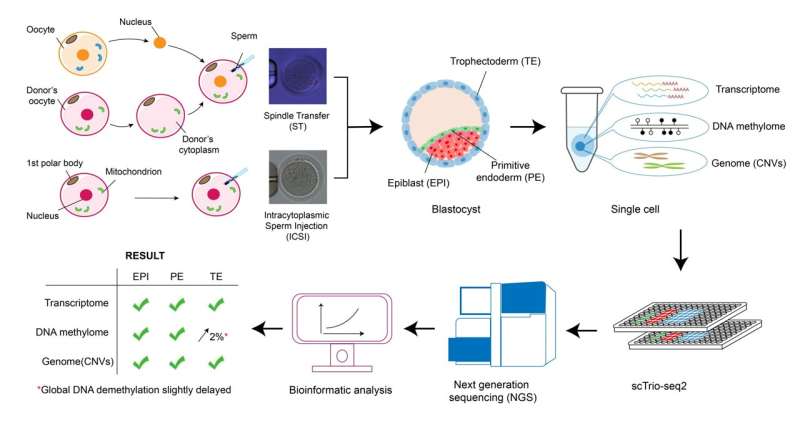Pre-fertilization DNA transfer to avoid mitochondrial disease inheritance appears safe

Transferring the nuclear genome from one egg into the cytoplasm of a donor egg is a strategy to enable women carrying mutations in their mitochondrial DNA to have healthy babies. A new study from Wei Shang of Chinese PLA General Hospital, Beijing, Fuchou Tang of Peking University, Beijing, and colleagues, publishing August 16 in the open-access journal PLOS Biology, uses multiple "omics" techniques to show that this strategy, called spindle transfer, is likely to be safe, with little evidence of genetic or functional difference between the resulting embryos and healthy control in vitro fertilization (IVF) embryos. The results are likely to spur further adoption of spindle transfer for IVF when there is a risk of mitochondrial disease.
Mitochondria, the energy powerhouses of the cell, contain their own DNA, mutations in which can cause a variety of inherited diseases, including metabolic, muscular, and neurologic disorders. In human reproduction, only maternal mitochondria, contained in the egg, are inherited. To interrupt that inheritance, techniques have been developed to place parental nuclear DNA into cytoplasm from donor cells carrying healthy mitochondria, either just before fertilization (spindle transfer), or just after (pronuclear transfer).
The "spindle" refers to the division apparatus that holds the nuclear chromosomes in suspension until fertilization. During spindle transfer, the maternal spindle is removed from an unfertilized egg and placed into a donor egg that has had its own spindle removed. (Pronuclear transfer removes the pronucleus, containing both egg and sperm DNA, and places it in a donor embryo whose pronucleus has been removed.) Spindle transfer has been used clinically, but there remain questions about its safety.
To shed light on this question, the authors performed three different types of analyses on single cells from 23 blastocysts following spindle transfer and compared them to 23 control IVF blastocysts. (The blastocyst is the multicellular ball that forms about 5 or 6 days after fertilization, ready for implantation into the uterine wall.) They found no difference in DNA copy number, a measure of genomic integrity, between spindle transfer and control blastocysts. RNA expression profiles were also similar between the two blastocyst types, regardless of which layer of the blastocyst the cells were taken from.
The authors did find a small but significant reduction in the level of DNA demethylation in spindle transfer blastocysts in one layer, the trophectoderm, though not in two other layers. DNA demethylation is one of the processes used to increase gene expression during development, and their analysis suggested that the reduction was evidence of a slight delay in the process, rather than a permanent inability to upregulate the affected genes. "It is quite possible that after the blastocyst stage, the spindle transfer embryos can catch up to complete DNA demethylation before implantation," Tang said.
"We conclude that spindle transfer seems generally safe and does not severely disturb embryonic development. However, given the limitation of the study, more dimensions and larger-scale evaluations are still needed to determine whether this technique can be applied to a wider set of clinical trials."
Tang adds, "Spindle transfer can potentially be used to prevent the germline transmission of mitochondrial DNA mutation related diseases. However, its safety has not been comprehensively evaluated. This study provided the first systematic analyses of the transcriptome, DNA methylome, and genome (copy number variations) of spindle-transferred blastocysts at single-cell resolution and revealed that spindle transfer procedure seems generally safe for embryonic development with only global DNA demethylation slightly delayed in trophectoderm lineage of blastocysts."
More information: Single-cell multiomics analyses of spindle-transferred human embryos suggest a mostly normal embryonic development, PLoS Biology (2022). DOI: 10.1371/journal.pbio.3001741
Journal information: PLoS Biology
Provided by Public Library of Science





















